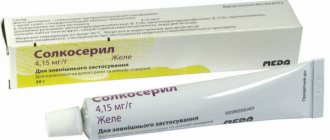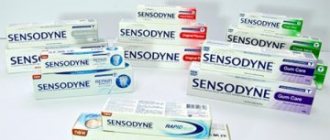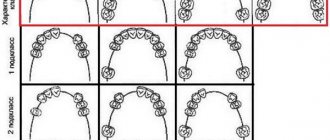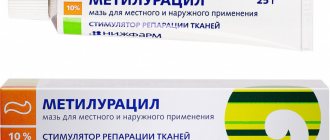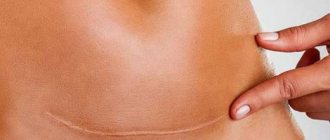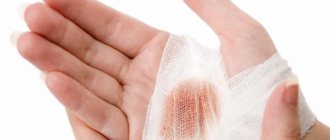"Levomekol" is an antibacterial combination drug for external use with a wide spectrum of action. Levomekol ointment prevents the spread of pathogenic microbes, eliminates swelling, accelerates wound healing, and also increases local skin immunity.
Levomekol for burns
This combination is provided by two active components in the ointment - Chloramphenicol (aka Levomycetin) and Methyluracil. Chloramphenicol is a natural antibiotic that actively blocks intestinal, pseudomonas and staphylococcal bacilli. And methyluracil accelerates the regeneration of the epidermis. The peculiarity of methyluracil is its ability to easily and quickly penetrate into the dermis, without affecting the membrane cell membrane. This process is associated with the removal of excess fluid from the intercellular space, which usually causes swelling and bruising.
What is Levomekol used for?
Levomekol has a multifaceted therapeutic effect:
- quickly reduces the inflammatory process, prevents its spread to healthy tissues;
- prevents the growth and reproduction of bacterial infectious agents;
- quickly eliminates swelling by normalizing microcirculation;
- ensures delivery of nutrients and biologically active substances, as well as molecular oxygen, to the affected tissues;
- stimulates the regeneration of inflammatory cells of all layers of the epidermis;
- increases immunity at the local level.
The ointment quickly removes all inflammatory processes on the skin
It is worth noting that the presence of purulent discharge and necrotic tissue does not prevent Levomekol ointment from performing its function. The drug can be used to disinfect and accelerate tissue regeneration.
Levomekol, ointment for external use, 40 g, 1 pc.
STADA, Russia
Price from 128₽
There are contraindications. Specialist consultation is required.
Indications for use of Levomekol ointment
Since Levomekol ointment has an antibacterial effect, and at the same time stimulates the restoration of tissue structure, the drug is indicated for the following diseases:
- infection of wounds with pathogenic microflora, ulcers and purulent abscesses on the epidermis;
- burns (mostly 2nd and 3rd degree);
- violation of tissue integrity due to injuries;
- necrotic processes;
- weeping and dry eczema;
- calluses;
- trophic ulcers;
- frostbite of the extremities (superficial layers of the skin);
- pimples, acne, carbuncles, boils;
- otitis and sinusitis (including with purulent discharge);
- treatment of sutures after surgery
- bedsores;
- haemorrhoids.
Levomekol ointment can be used for children
"Levomekol" can be used for children from 1 year. But before this, it is imperative to consult a pediatrician.
Types of wounds
They can be:
- Operating: applied deliberately for the purpose of performing an operation.
- Accidental: as a rule, these are household damages.
Depending on the nature and conditions of the damage, wounds are distinguished:
- chopped;
- I stab;
- bruised;
- torn;
- crushed;
- chopped;
- bitten;
- mixed;
- firearms.
In children , cut, puncture, bitten, mixed, and also superficial (abrasions, scratches, etc.) predominate. Particular attention is paid to bites that result from an animal or human bite (for example, another child), as they are the most infected. This is due to the large number of harmful bacteria in the oral cavity. They are most often complicated by infection.
According to the degree of infection there are:
- Freshly infected. As a rule, this damage occurs within 3 days from the date of its application. Defects with soil contamination are especially infected.
- Purulent. An infectious process develops in these lesions. Microbes, when multiplying, lead to increased inflammation, necrosis, and also contribute to the appearance of pus. Children with purulent manifestations develop symptoms of general intoxication: nausea, headache, dizziness, weakness, lethargy.
Contraindications
Like many drugs, Levomekol has contraindications:
- individual intolerance to the components of the medication;
- hypersensitivity of the body;
- fungal infections of the epidermis;
- tendency to allergic reactions;
- psoriasis.
The official instructions for use indicate that in pediatrics the ointment is prescribed starting from 3 years of age. However, many pediatricians, based on the harmlessness of Levomekol, allow its use from infancy.
Why does aphthous stomatitis occur?
As noted above, the causes of aphthous wounds in a person’s mouth can be both local and general somatic in nature. Let's look at the main ones.
Local causes of aphthous stomatitis:
- Mechanical damage to the human oral mucosa. Such injuries occur as a result of a person eating hard and tough foods. Often, even a small scratch on the roof of the mouth can cause aphthous stomatitis.
- Thermal lesions of the human oral mucosa. The occurrence of wounds and the development of aphthous stomatitis in this case provoke burns of the mucous membrane, which a person could receive by consuming hot drinks or food.
General somatic causes of wounds in the human oral cavity:
- Heredity factors. The predisposition to the occurrence of aphthous stomatitis in the mouth may be determined by genetic reasons. Therefore, there is a risk of developing this disease and the manifestation of a chronic form of stomatitis (when ulcers on the mucous membrane appear regularly) in people whose parents also suffered from this disease.
- Somatic diseases. Aphthous stomatitis often develops in people who suffer from any secondary somatic diseases. For example, these could be diseases of the digestive system and gastrointestinal tract.
- Weak immunity. For this reason, children are susceptible to oral ulcers because their immunity is not yet fully developed. In a child, aphthous stomatitis is more severe than in an adult and is accompanied by an increase in temperature and a deterioration in general well-being. Against the background of colds, immunity is also often reduced, and aphthous stomatitis occurs in the person’s mouth.
- Avitaminosis. With an incorrect diet, a person does not receive enough substances necessary for the successful functioning of the body. Due to a lack of vitamins C and B or microelements such as selenium, folic acid, zinc or iron, in some cases aphthous stomatitis occurs in a person’s mouth.
- Allergy. An allergic reaction associated with eating foods such as citrus fruits, nuts (especially peanuts), chocolate, red berries (strawberries, wild strawberries) or foods containing gluten (cereals, pasta) in some cases leads to the appearance of canker sores. wound in a person's mouth.
- Stress. When a person finds himself in a stressful situation, he spends significant resources to cope with the current problem. This leads to a loss of strength, decreased immunity and a general weakening of the body, as a result of which wounds form in the person’s mouth and he develops aphthous stomatitis.
Side effects
Levomekol is considered a universal drug and is usually well tolerated by patients. But in case of overdose (if the drug is used for more than a week), allergic skin reactions may occur.
- hyperemia;
- burning;
- itching;
- urticaria;
- dermatitis at the site of application;
- local swelling;
- When using vaginal tampons, candidiasis may occur.
No incompatibility with other medicinal products has been reported. Make sure that the ointment does not get into your eyes, mucous membranes or inside. In case of contact with eyes and mucous membranes, rinse them immediately with running water. If swallowed, the stomach must be rinsed.
Main manifestations of wounds
Pain
In this case, pain occurs due to damage to the nerve endings that were located at the site of the injury. Over time, swelling may increase, which also leads to increased pain. The severity and degree of manifestation of pain depends on factors such as:
- location of the defect, concomitant damage to large nerve trunks;
- type of weapon or conditions of damage (asphalt, garden, bicycle, sharp object, etc.);
- psychological state of the child.
In essence, pain is an adaptive defense reaction of the body.
Bleeding
Any damage to the skin or mucous membranes is in one way or another accompanied by damage to blood vessels (capillaries, arteries, veins). The nature and degree of bleeding depends on the type of damaged vessel. The larger the vessel and the higher the pressure in it, the more massive the bleeding, and vice versa. It is worth highlighting those places on the body that are accompanied by more heavy bleeding: face, head, neck, hands . In these places, the tissues are better supplied with blood. The condition of the blood coagulation system plays an important role. If a child has a minor abrasion or scratch, which is accompanied by prolonged and heavy bleeding, then it is necessary to consult a pediatrician and pediatric hematologist in order to exclude a disease of the blood coagulation system. This may also be indicated by the appearance of a large number of bruises for no reason.
If a small abrasion is accompanied by prolonged and heavy bleeding, then it is necessary to consult a hematologist.
Hiatus
This phenomenon is associated with a reduction in the elastic fibers of the skin. As a result, the skin edges of the lesion diverge. Many surgeons know what Langer's lines are. They indicate the course and direction of the fibrous structures of the skin. For this purpose, incisions are made along these lines, which leads to rapid healing of the incisions and reduction of gaping. Accordingly, when a defect appears perpendicular to these lines, a wide divergence of the edges of the defect develops.
Levomekol in the treatment of burns
For burns, Levomekol is needed to prevent infection of the wound surface with pathogenic infections, as well as to accelerate tissue healing. Levomekol also copes with inflammation, which can lead to suppuration of the wound. The ointment cleanses the affected area well from both purulent discharge and necrotic cells.
The treatment system for a small area burn of 1-2 degrees is as follows:
- before applying the ointment, the wound is washed under running water;
- the ointment is applied to a sterile gauze pad, which is applied to the wound surface;
- the bandage is applied for a day;
- dressings are done every day - up to 5 times a day.
The burn is treated until the tissue is completely healed. The total duration of the course for minor household burns is 5 – 14 days.
How to get rid of sores in the mouth?
Stomatitis wounds that occur in the human mouth, in most cases, heal on their own within 7-10 days after formation. But timely treatment of aphthous stomatitis is necessary in order to prevent the formation of ulcers on the human oral mucosa again. The fact is that the acute form of stomatitis, which is characterized by the sudden appearance of wounds of various sizes on the upper and lower palate in a person’s mouth, if the problem is ignored or the wrong treatment is carried out, tends to develop into a chronic form of the disease. Wounds in the oral cavity with chronic stomatitis appear periodically and bother a person from time to time throughout life.
To exclude the possibility of aphthous stomatitis ulcers reoccurring, dentists perform the following treatment:
Local therapy
. It involves treating wounds on the oral mucosa with antiseptic agents: gels, ointments or sprays. During this treatment of stomatitis, a person is prescribed daily rinses with solutions such as furatsilin, chlorhexidine, miramistin, etc.
General therapy.
It includes a set of measures to cure this disease and at the same time strengthen the body. To strengthen the body, the doctor prescribes immunomodulatory drugs and vitamin courses to the person. To combat aphthous stomatitis, different drugs are used, depending on the nature of the disease and the causes of its occurrence: antihistamines, antivirals, steroids or antibiotics.
The selection of funds for the treatment of wounds with aphthous stomatitis is carried out only by a doctor and occurs after a visual examination of the person’s oral cavity, conducting the necessary diagnostic tests and making a diagnosis. The LeaderStom Clinic offers to use the services of our experienced doctors to carry out these operations.
Levomekol in the treatment of acne
"Levomekol" has an antibacterial and wound-healing effect, therefore it is widely used in dermatology, in particular, in the treatment of acne. The course of treatment depends on the severity of the disease and the number of skin rashes.
Small pimples are treated by applying a thin layer of ointment to the affected area. This is done in the evening for several hours, and before bedtime Levomekol is washed off. Within two weeks, pimples disappear, facial skin becomes even, and small scars heal.
Treating acne with ointment
Levomekol is applied to isolated inflamed pimples in a thin layer, covered with a small piece of cotton wool and left for 2-3 hours. Therapy lasts 2-3 days.
As for opened pimples, the medicine is placed directly into the resulting holes.
To treat acne, Levomekol is applied to the affected area overnight. In the morning, the ointment must be washed off. Typically, the course of treatment takes 2 weeks, during which the inflammation subsides and the acne breaks out or resolves.
To eliminate subcutaneous acne, you need to do the following:
- after washing with soap, the skin is cleansed with any tonic or lotion;
- Apply the ointment in a thin layer on a sterile napkin and apply it to the area of skin with acne;
- the bandage is fixed with adhesive tape.
The duration of the treatment procedure is 3-5 hours. If deep, painful ulcers appear on the skin, keep the bandage on the body all night.
The duration of therapy is about 7-10 days, depending on the degree of damage to the dermis.
Sores in the mouth as a sign of aphthous stomatitis
Wounds in the mouth can arise as a result of the development in a person of a separate independent disease of the oral mucosa, caused by the growth and development of pathogenic microorganisms. But, in addition, the cause of such wounds may also be hidden in the general somatic condition of an adult or child.
In most cases, mouth ulcers are symptoms of a disease such as canker sores. Stomatitis is a lesion of the human oral mucosa that occurs as a result of an atypical reaction of the immune system to foreign irritants. Depending on the nature and causes of the disease, stomatitis can be of various types: ulcerative, herpetic, allergic, vesicular, etc. But people most often have to deal with the aphthous form of this disease.
Let's name the main symptoms of aphthous stomatitis:
- The appearance of round ulcers (ulcers) in a person’s mouth, which are grayish in color and surrounded by a red, inflamed rim. Ulcers are located either separately or in groups and have different sizes.
- Painful sensations in the affected areas of the upper and lower palate of a person that occur during eating, drinking, or talking.
- Deterioration of a person’s general well-being, weakness.
- Temperature increase. But this is not a mandatory symptom; it occurs in most cases in children, since they are more difficult to tolerate aphthous stomatitis in the oral cavity.
- Enlarged submandibular lymph nodes. This symptom of aphthous stomatitis also occurs more often in children than in adults.
Levomekol in the treatment of hemorrhoids
Levomekol ointment can be used as an addition to complex therapy for hemorrhoids during periods of exacerbation. It is recommended to use the ointment in cases where blood is released from the hemorrhoids. Since the drug has an antibacterial effect (wounds can be infected with feces), helps relieve inflammation and neutralize pathogenic bacteria, Levomekol is prescribed for the regeneration of anal tissue.
- it is necessary to wash the perineum and anus with soap and water and dry with a soft towel;
- apply a thin layer of ointment to the anus before going to bed;
- the area of influence from above is covered with a bandage and fixed with an adhesive plaster;
- When treating internal nodes, a tampon is soaked in ointment, which is then inserted into the anus.
Levomekol for hemorrhoids
The duration of therapy is 10 days. Since Levomekol is not a specialized antihemorrhoidal drug, after the inflammation has resolved, the decision to continue therapy and prescribe medications is made only by the attending physician.
Levomekol in the treatment of wounds
Levomekol helps heal damaged tissue and prevents infection of the wound surface. Moreover, it is not so important whether the wound has festered or not. If the wound is not purulent, then first the affected area is treated with an antiseptic. The ointment is applied in a thin layer overnight, then it must be covered with a sterile gauze cloth and secured with a bandage. Most often, wound treatment is required once a day.
If the wound festers, then using cotton-gauze swabs moistened with an antiseptic, the pus and secreted secretions are removed. Then Levomekol ointment is applied to the wound - it should be completely filled, but not too tightly. The affected area is covered with a gauze cloth, also soaked in ointment. As for the frequency of changing the bandage, it all depends on the amount of pus released. Usually a double dressing is sufficient.
And if the wound is deep and accompanied by an infectious lesion, then Levomekol is preheated to 35 degrees Celsius, then a sterile napkin is soaked in ointment (several can be used if the affected area is large) and injected into the lesion. If the affected area is large, use several napkins with Levomekol. It is important that the wound is filled completely, but not too tightly.
Note that to administer the medication into puncture and deep wounds, it is better to use a rubber drainage tube, and inject the heated ointment itself using a syringe.
The duration of therapy usually lasts from 5 to 10 days.
Perineal injuries are one of the most common complications of childbirth, they occur in 40-65% of cases [1, 3]. Infectious complications develop in every 4-5th postpartum woman, leading to suppuration and divergence of the perineal sutures, wound healing by secondary intention. In addition to septic complications, poor healing of the perineal wound can subsequently lead to dyspareunia [5] and secondary genital diseases [4].
The wound healing process is divided into three main phases [2]:
- inflammatory or exudative phase, during which changes occur that determine the entire further course of wound healing;
- proliferative phase, which is the main phase in tissue restoration, aimed at the development of granulation tissue;
- differentiation (reorganization) phase, including maturation and scar formation.
When treating a perineal wound, the nature of its healing is of exceptional importance (N.A. Volkov, 1986). During wound repair, granulation tissue is formed in it based on the proliferation of capillary endothelium and fibroblasts. The main functions of fibroblasts are the synthesis of collagen from amino acids entering the cell. The resulting microvessels ensure the delivery of oxygen to the cells and represent a kind of biological basis from which the migration of collagen-producing fibroblasts occurs. As the wound defect fills, the granulation tissue becomes denser, the number of microvessels decreases, some of them become empty, and the number of cellular elements - macrophages, mast cells and fibroblasts - decreases. Epithelization of the wound begins, the speed of which is 1 mm along the perimeter of the wound in 7-10 days. The most important condition for successful wound healing is a strict pathogenetic focus of treatment, which determines the synchronization of epithelization processes, on the one hand, and the maturation of granulation tissue, on the other (N.A. Volkov, 1986). Traditionally, the leading role in solving this problem belongs to ointments. The therapeutic effect of the ointment is determined by the drugs included in its composition and the effects that the ointment bases have.
One of the drugs that has a positive effect on the healing process is Pantoderm ointment (JSC Akrikhin). Pantoderm contains dexpanthenol (provitamin B5), which forms an active metabolite - pantothenic acid. Pantothenic acid is a component of coenzyme A, which is involved in acetylation processes, stimulates the regeneration and restoration of skin cells and mucous membranes, increases the strength of collagen fibers and has a weak anti-inflammatory effect.
The purpose of the study was to study the effectiveness, safety and tolerability of the use of pantoderm (ointment) in postpartum women with perineal dehiscence in the second and third phases of the wound process.
Material and methods
In the postpartum department of the Research Institute of AG named after. BEFORE. Ott RAMS examined 30 postpartum women with suppuration of the perineal sutures.
When treating purulent wounds of the perineum, we took into account the phases of the wound process. Thus, in the first phase (inflammation phase), treatment tactics were based on well-known surgical principles, requiring separation of the edges of the wound at the site of suppuration, drainage and regular treatment of purulent cavities with antiseptic solutions. The patients received antibacterial, detoxification therapy, physiotherapy and local wound treatment using various drainages and agents with these properties. After cleansing the wound and the onset of the granulation phase, the postpartum women were divided into 2 groups: 20 women (main group) had pantoderm (ointment) added to the treatment regimen, and 10 patients (comparison group) were treated with methyluracil ointment. After daily standard treatment, pantoderm or methyluracil ointment was applied to the wound surface 2 times a day; treatment was carried out in an open manner.
The effectiveness of drug treatment was assessed by dynamic changes and the degree of activation of reparative processes and took into account:
1) subjective factors: complaints of pain, discomfort and burning sensation in the wound area;
2) objective data: the condition of the wound was assessed, namely the nature of granulation, the rate of epithelization and the timing of wound healing;
3) laboratory data: clinical blood test parameters were assessed, the leukocyte intoxication index (LII), data from bacteriological examination of discharge from the wound were examined, histological and immunohistochemical examination of perineal tissue was carried out.
Results and discussion
The age of the subjects ranged from 19 to 37 years. Of these, 25 (83.3%) were primiparous, 5 (16.7%) were multiparous, and 9 (36%) were primiparous aged 27 years and older. All postpartum women had a history of various extragenital and gynecological (mainly inflammatory) diseases. In 82% of women during childbirth, the period of expulsion was shortened using perineo- or epizotomy due to a threatening perineal rupture, high myopia, disruption of fetal activity, operative delivery - the application of a vacuum extractor or exit obstetric forceps; 18% of postpartum women had perineal ruptures of I and II degrees. In the postpartum period, among the 30 examined postpartum women, 19 (63.6%) patients were diagnosed with partial dehiscence of the perineal sutures, 9 (30.0%) had a suppurating infiltrate, and 2 (6.4%) postpartum women had a complete dehiscence of the perineal sutures with subsequent application of delayed secondary sutures. Complications of the postpartum period are presented in table. 1.
The use of Pantoderm in postpartum women of the main group showed that the ointment has pronounced healing properties. When examining the wound in patients of the main group, a more rapid appearance of healthy granulations was noted, which were characterized by a bright pink or red color, were distinguished by a shiny surface and easy bleeding, which indicated the good reparative properties of pantoderm. On the 4-6th day from the start of treatment with pantoderm, the entire wound was treated with granulation, a reduction in the area of the wound and the appearance of marginal epithelization were noted. Final epithelization of the wound took 6-9 days (on average 8±1.2 days). In the comparison group, the clinical picture of the course of the wound process at similar times was comparable, however, the appearance of granulations and epithelization of the wound occurred 1-2 days later than in the main group (Table 2, Fig. 1).
Figure 1. Timing of the appearance of granulation and epithelization in patients of the main group and the comparison group.
The postpartum woman with complete dehiscence of the perineal sutures in the main group had a worse condition of the wound, which served as the basis for an earlier (on the 9th day of the postpartum period) operation of applying secondary sutures to the perineal wound than in the patient from the control group (11th day). In both cases there was a smooth course of the postoperative period.
Thus, the rate of wound healing in phases II and III of the wound process when using Pantoderm was more intense than in postpartum women in the comparison group.
The leukocyte index of intoxication on days 2-3 and 5-8 after birth in patients of the study groups exceeded that during the normal course of the postpartum period by 1.5-2 times. As a result of conservative and surgical treatment, it decreased and corresponded to normal values. The increase in LII was facilitated not only by the presence of an inflammatory process in the tissues of the perineum, but also by the addition of endometritis in 3 subjects (10%), uterine subinvolution in 12 patients (40%), and pathological lactostasis in 1 postpartum woman (3.3%).
During a bacteriological study of discharge from the perineal wound in postpartum women of both groups, gram-negative microflora was isolated in 64.5%, Staphylococcus aureus
- in 23%, anaerobes - in 12.5%. Every third patient had a mixed aerobic-anaerobic flora.
Treatment with Pantoderm was not accompanied by side effects: the ointment was well tolerated by the patients, in no case was there any local irritation or allergic manifestations, and the formation of keloid scars was not observed. The forming scar in patients of this group was more elastic than in postpartum women in the comparison group. This fact, in addition to its aesthetic appearance, characterizes better extensibility of the perineal tissue, which indicates less trauma during subsequent births. Due to the fact that the ointment contains lanolin, it was noted that under the influence of body temperature, lanolin lost its viscosity and the ointment easily filled the wound cavity.
Histological examination of perineal tissue in women from the comparison group (Fig. 2)
Figure 2. Pronounced proliferation of mature fibrous tissue in postpartum women from the comparison group. Staining with picrofuchsin using the Van Gieson method. Uv. 100, 200. In the stromal component, a more intense formation of mature fibrous tissue was noted, and therefore, in the clinical picture of healing of the perineal wound, deformation of the perineal skin with areas of retraction (scar changes) was observed in .1/3 of the patients. No such changes were detected in postpartum women of the main group (Fig. 3).
Figure 3. Mild diffuse subepithelial fibrosis in postpartum women of the main group. Staining with picrofuchsin using the Van Gieson method. Uv. 100, 200.
When quantitatively assessing mast cells in the underlying stromal component in postpartum women of the main group, their significant decrease was noted (Fig. 4),
Figure 4. Quantitative assessment of mast cells in the underlying stromal component in postpartum women of the examined groups. Note.*—differences between groups are significant (p<0.05). which indicated a lower activation of the immediate-type hypersensitivity reaction compared to that in patients of the comparison group.
The degree of cell proliferative activity was assessed by the expression of Ki-67 (an index of proliferative activity) in the basal layer of multilayered squamous epithelium. In the main group (Fig. 5)
Figure 5. Expression of Ki-67 in the layer of stratified squamous epithelium in postpartum women of the main group. Uv. 100, 200. When using Pantoderm, there was a significant difference in the proliferative activity of cells compared with that in the comparison group (Fig. 6),
Figure 6. Expression of Ki-67 in the layer of stratified squamous epithelium in postpartum women from the comparison group. Uv. 100, 200. which indicated a higher degree of wound epithelization in patients of the main group.
To study the degree of tissue vascularization, an immunohistochemical study of CD31 was carried out, followed by an assessment of the relative area in the preparations.
Figure 7. Expression of CD31 in the stromal component in postpartum women of the examined groups. Note. *—differences between groups are significant (p<0.05). The immunohistochemical study performed complemented the histological study of the perineal tissue and gave reason to believe that in the postpartum women of the main group, where Pantoderm was used, the degree of vascularization of the stromal component of the scar area was higher than in the postpartum women of the comparison group.
As a result of the study, it was proven that pantoderm (ointment) has a pronounced stimulating effect on regeneration processes in the wound, promotes the growth of granulation tissue and faster wound healing. When using it, more active epithelization of the perineal wound is observed compared to that in the comparison group (on average by 2 days). The ointment is well tolerated by postpartum women and does not cause side effects or allergic reactions.
Histological and immunohistochemical studies confirm the effectiveness of using Pantoderm for the healing of infected perineal wounds. The examined patients showed an improvement in vascularization, which was reflected in an increase in the metabolic and functional activity of the damaged tissue. This led to a weakening of inflammatory cell infiltration in the underlying stroma, a decrease in fibrosis processes and a decrease in the formation of scar tissue changes. There was a higher mitotic activity of the basal layers of multilayered squamous epithelium, characterizing a high degree of epithelialization of the tissue.
conclusions
1. Pantoderm (ointment) has a pronounced stimulating effect on the regeneration processes in the wound, promotes faster wound healing.
2. When using pantoderm, more active epithelization of the perineal wound is observed, reducing the formation of scar tissue changes.
Use of Levomekol ointment in gynecology
Levomekol is successfully used in gynecology and urology.
In gynecology, therapy is carried out using tampons with ointment applied to them. A similar method is indicated for the treatment of the following conditions:
- inflammatory erosion of the cervix;
- inflammation of the uterine appendages (ovaries, fallopian tubes);
- divergence of vaginal sutures after ruptures during childbirth or operations.
The treatment system consists of the following sequence of actions:
- before use, a woman must thoroughly wash and dry the skin of the treatment area and perineum;
- if therapy is used after the divergence of vaginal sutures or after operations, then the sutures must be treated with a weak solution of potassium permanganate or furatsilin;
- you need to make a small cotton swab, put an ointment on top of it measuring 15 mm x 15 mm, and 5 mm high;
- insert into the vagina at night and remove in the morning;
- if therapy is used after the divergence of vaginal sutures or after operations, then the ointment is applied to a gauze bandage and applied to the sutures. Then put on clean underwear (if necessary, you can additionally use a pad). The dressing remains on for 2 to 6 hours.
Using the method described above, the active substance of the ointment is delivered to the affected area and absorbed into the surrounding vaginal tissue.
In urology, Levomekol is used in the treatment of balanitis and balanoposthitis in men, as it has anti-inflammatory and antimicrobial effects. The treatment system consists of the following sequence of actions:
- before applying the ointment, the head of the penis is washed with a weak solution of potassium permanganate or furatsilin, removing pus and dead tissue;
- Levomekol is applied to the affected area in a dense layer.
The remedy is applied 1-2 times a day until complete recovery. After the inflammation is relieved, Levomekol is applied for another week, 1 time per day - in the evening, before bedtime.
Ointments for wound healing after surgery
In principle, after surgery, the doctor may prescribe one or more of the ointments listed above. But there is also a separate group of drugs, which often include silicone, which serves to reduce itching in a postoperative wound. In addition, with long-term use, these products allow (or at least try to allow :)) to avoid scars after surgery, reducing the size and severity of future scars.
- Dermatix is an expensive but effective drug, widely used including in plastic surgery. It fights scars well, moisturizes damaged skin, and stimulates microcirculation. Suitable for use by pregnant and lactating women. IMPORTANT! Although Dermatix works well for cosmetic post-surgical defects, it does not have an anti-inflammatory effect.
Gel Dermatix Ultra, 15 g
Hanson Medical (USA)
Available in 76 pharmacies
891 UAH
Order
- Contractubex is another well-known drug with heparin, allantoin and onion extract. Relieves inflammation, improves microcirculation, inhibits the growth of connective tissue (the scar itself). IMPORTANT! Contractubex works best on fresh postoperative scars, immediately after removal of sutures, but it cannot handle old scars.
Contractubex gel tube 20 g
Merz Pharma (Germany)
Available in 397 pharmacies
371 UAH
Order
Levomekol or Vishnevsky ointment. What's better?
Let's start with the fact that Vishnevsky ointment and Levomekol, although they are used in similar cases, still have a multidirectional spectrum of action. Thus, Vishnevsky ointment is effective when the wound is in the process of regeneration. Therefore, it cannot be used when the wound is suppurated or severely inflamed. Yes, the drug contains an antiseptic, but its concentration is not enough to provide a bactericidal effect. Moreover, tar and castor oil stimulate blood circulation in the affected area, which worsens the situation.
This is why Vishnevsky’s ointment is not as effective, since Levomekol has higher antibacterial activity due to the presence of an antibiotic in it and accelerates the process of outflow of pus from the wound. Also important are the following distinctive features that determine the superiority of Levomekol ointment:
- no unpleasant odor;
- higher repair characteristics;
- does not provoke irritation in the treatment area;
- when treating boils, Levomekol quickly initiates an abscess and opening of the abscess, followed by wound healing.
But if Vishnevsky ointment helps the patient, then there is little point in changing it.
Classification of drugs that promote wound healing
Drugs that promote wound healing include:
- vitamin preparations: dexpanthenol;
- hyaluronic acid preparations: zinc hyaluronate;
- herbal preparations: sage, calendula, larkspur, gray alder, sticky alder, Japanese sophora, cinquefoil, yarrow;
- preparations of animal origin: deproteinized hemoderivative from the blood of dairy calves, propolis;
- other wound-healing drugs: methyluracil, thiotriazoline.
In addition, there are combination products that contain wound-healing drugs along with antibiotics and antiseptics that are used for infected wounds: methyluracil + chloramphenicol; dexpanthenol + chlorhexidine; methyluracil + miramistin.
Analogs
Analogs of Levomekol ointment have a bactericidal and healing effect. But the difference lies in the active ingredient of the drug. So, among the analogues one can name Fugentin, Levosin (additionally has an analgesic effect), Protegentin, Fastin-1, Salicylic-zinc paste.
Synonyms, that is, drugs with the same substance (but in higher concentration) as Levomekol ointment, can be considered Netran and Levomethyl. Substitute medications can only be prescribed by the attending physician.

